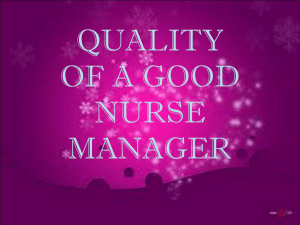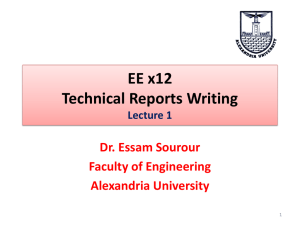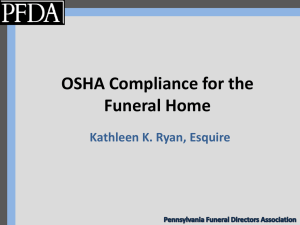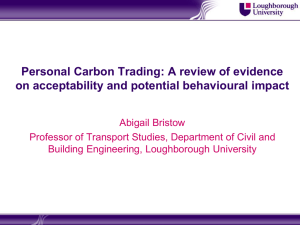Lucien Nel - Presentation
advertisement
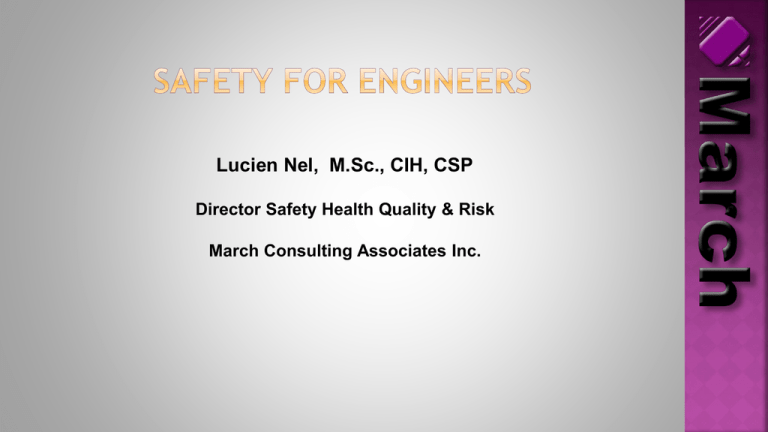
Lucien Nel, M.Sc., CIH, CSP Director Safety Health Quality & Risk March Consulting Associates Inc. Introduction relevance; technological change; demands Fundamentals Importance; terms; concepts; 15 min break; workplace; management Conclusion threats; maintenance; mantra; final thoughts Reading list You are the teachers, leaders and workers of the future You will have to decide how to do the work safely Very rarely will you meet all three criteria Meet any two of these criteria Transportation Communication and electronic technologies Medicine Learning new things all the time 2. Better and faster information access 3. Aided in making life easier, safer and healthier 4. Better decision making 1. A. Too much information to be useful B. Social and political difficulties C. Unknown health effects D. Safety problems E. Decision paralysis (Brauer, 1994) New hazards Increased accidents New unproven concepts, design & materials Health impacts (U.S Department of Labor, 2008) Embraces the benefits Regulation and litigation Structured health and safety organizations Insurance Society accepts the benefits but not all the risks Society places demands on engineers to reduce risks Engineers require training in workplace safety, due diligence and product liability in addition to their electrical training to meet these demands Safety, accident Danger, hazard and risk Hazard control Risk reduction Source Transmission medium Anatomy of a Hazard Receiver Incident (Brauer, 1994) United States Department of Labour (OSHA) Hospital patients require special mention because they may have electronic equipment attached inside and outside their bodies. Small currents may leak from the instruments to other instruments with a potential to cause injury and death Why is this such an “At risk group”? How can the risk be reduced? Electricity is one of the leading causes of fire ARC Flash Arcing in the presence of flammable or combustible aerosol Grain elevators Fiery mines Chemical factories Petrochemical plants Gas stations service stations Safety triangle (incident : accident ratio theory) Review work to be done Tour the site Write down hazards and analyze them Develop a plan to control hazard Eliminate the hazard by removing it or removing people Reduce the hazard by substitution Safety device / warning device Warning labels & procedures PPE BREAK 15 Mins Some workplace safety rules Permits Tools Housekeeping Electrician Water Disconnect ABC fire extinguisher Ground ground ground ground ground! Warning signs Tingle Frayed, dry, cracked extension cords Overheating Smoke, sparks, spilled liquid, erratic operation Lock-out tag-out Fall protection Confined space entry Work permits / orders Ground penetration permits Hot work permits Confined space entry permits Safety permits Tie-in permits Special / Unique permits Prevent slips trips and falls Maintain fire safety Appropriate storage of tools and equipment Contain potentially hazardous materials and equipment Policy Programs Procedures Work Instructions Schedules & planning sessions Resource deployment Coordination with production / operation / construction Corrective action planning & verification of completion Poor work planning threatens the safety of workers including engineers To be successful, take the safety knowledge you gained from this seminar, build on it, and apply it throughout your studies and especially when you are in the workplace No task is so important that we cannot take the time to do it safety With this knowledge, will you be able to: Do things safety and still meet public expectations of: expediency; appropriateness; and, fiscal responsibility. Knowledge and proper planning will get us there safely Brauer, Roger L., Safety and Health for Engineers, John Wiley and Sons, New York, NY, 1990. Grimaldi, John V., and Simonds, Rollin H., Safety Management, 5th Edition, Irwin, Homewood, IL,1989. Hammer, Willie, Occupational Safety Management and Engineering, 4th Edition, PrenticeHall,Englewood Cliffs, NJ, 1989. Hammer, Willie, Product Safety Management and Engineering, 2nd Edition, American Society of Safety Engineers, Des Plaines, IL, 1993. Molak, Vlasta (editor), Fundamentals of Risk Analysis and Risk Management, Lewis Publishers, Boca Raton, FL, 1997. Roland, H. E., and Moriarty, B., System Safety Engineering and Management, 2nd Edition, John Wiley and Sons, New York, NY, 1990. Sanders, M. S., and McCormick, E. J., Human Factors in Engineering and Design, 7th Edition, McGraw-Hill, New York, NY, 1993 Slote, Lawrence, Handbook of Occupational Safety and Health, John Wiley and Sons, New York, NY, 1987. Brauer, Roger L., Safety and Health for Engineers, John Wiley and Sons, New York, NY, 1990. CBS News, U.N.: World Population Increasingly Urban, http://www.cbsnews.com/stories/2008/02/26/world/main3880698.shtml?source=RSSattr=HOME_3880698, March 2, 2008, 11:51am Complete Compliance Consulting, Your business needs in Safety, Human Resources, Loss Prevention and USDOT compliance, http://completecomplianceconsulting.com/safety, accessed March 4, 2008 Everly, Mike, Accident Investigating and reporting, Cambrian Safety Consultancy, http://home.freeuk.net/mike.everley/download/ac.pdf accessed March 1, 2008 Owen media Partners Inc. A world of Safety: Personal Protective Equipment, http://www.safetyworld.com/topics/ppe.htm, accessed March 4, 2008 Saskatchewan Construction Association, Confined spaces, http://fpscsa.sasktelwebhosting.com/resources/st_confinedspaces.html, accessed March 4, 2008 Saskatchewan Labour, The Occupational Health and Safety Regulations,1996 being Chapter O-1.1 Reg 1 as amended by Saskatchewan Regulations 6/97, 35/2003, 112/2005, 67/2007 and 91/2007, Saskatchewan, 2007 UK Health and Safety Executive, A short guide to the Personal Protective Equipment at Work Regulations 1992, http://www.hse.gov.uk/pubns/indg174.pdf, accessed March 3, 2008 U.S. Department of Labor, Occupational Safety& Health Administration, Construction Safety, http://www.osha.gov/SLTC/etools/construction/electrical_incidents/mainpage.html, Accessed March 3, 2008, Young, Jay A., Laboratory Safety Information: Keynote address, 48th NEACT Summer Conference at the University of Main, Orono, Maine,August 18-22, 1986 http://people.bu.edu/basu/CL/EK306/labsafety.html, accessed March 3, 2008 Western Safety Products, Tie-Off Information & OSHA Information and Fall protection deceleration distances, http://www.westernsafety.com/gemtor/gemtorpg5.html, accessed March 3, 2008

